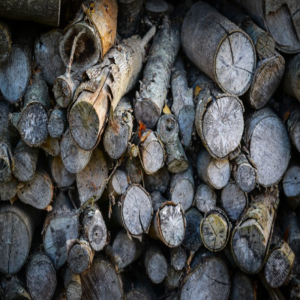Firewood – Seasoning and Drying

Energy Efficiency
Green wood will burn, but seasoned, dry wood has more heat value and will not deposit excessive creosote in chimneys and stovepipes. Any moisture in wood reduces the available heat because some heat is lost in the process of changing water to steam which then escapes, allowing the wood to burn. The net usable heat in wood is lost at the rate of about 1,380 Btu’s per pound of water.
Firewood should be cut at least 6 to 9 months before burning. Keeping the leaves on the summer-cut trees for at least a week or until they wither helps remove a great deal of moisture from wood. So, if you cut trees in the summer, don’t remove tops and limbs for at least a week. The leaves will draw moisture from the wood and dry it more quickly than if you limb the tree immediately.
Accelerate Seasoning
Seasoning can be accelerated by stacking firewood in a single tier in a sunny location. Both ends of the pieces should be exposed. Remember, the greater the surface area exposed to the air, the faster the drying.
You can further accelerate the drying process by covering the stack with a plastic cover. On sunny days, temperatures under the plastic covering will rise much higher than outside temperatures. This will warm the wood and evaporate the moisture. Some water vapor will condense on the plastic, so adequate ventilation is necessary. The plastic should be held off the ends of the firewood to allow air to flow and to keep condensation from wetting the wood. Moisture loss is always greater from the ends of wood.
Seasoning time for different species varies under different atmospheric conditions, but Table 1 provides good approximations.
A basic bathroom scale can be used to determine if your firewood is still seasoning (losing weight). Weight a basket or a small bag of a few pieces of firewood. Then place them back in the wood pile as an identified unit. Check the weight again in about one month. If they have lost weight, the wood is still drying. Also, cracks that appear in the end of logs are good signs that the wood is well-seasoned.
Generally, wood that is cut to length, split, and stacked in the open (preferably with a cover) during the winter should be thoroughly seasoned by the next heating season.
Storage
Store firewood away from the house to reduce the tracking in of dirt, sawdust, and bark. Also, insects are attracted to wood that is drying, and woodpiles next to the house can serve as an entry point.
Store firewood under cover to keep it dry and its fuel value high. Even better, keep wood stored in a warm, closed shed. It will produce more heat than wood stored outside because some heat is lost in warming the moisture in the wood from the outside temperature to the temperature of steam. Be sure to keep sufficient air space around the wood wherever it is stored.
If you have enough space to store wood under a roof, seasoning and storage can be accomplished with one handling. Outside, uncovered wood will dry to between 14 and 25 percent moisture content, depending on temperature, humidity, and wind. In a closed woodshed, firewood may dry to a 10 to 15 percent moisture content. In a heated house, moisture content can drop to 5 to 12 percent.

Meet the Author
Dr. Todd Shupe is the President of Wood Science Consulting, LLC. He is a well-recognized expert on wood forensics, wood preservation, wood decay and degradation, and wood species identification. He has a broad background in new product development, quality management, and marketing and sales in both the public and private sectors. For more information please visit DrToddShupe.com.
We welcome your comments below.
Thank you for visiting. We trust that you have enjoyed reading our articles.
Liked this post? Read more below or search for more topics . . .

